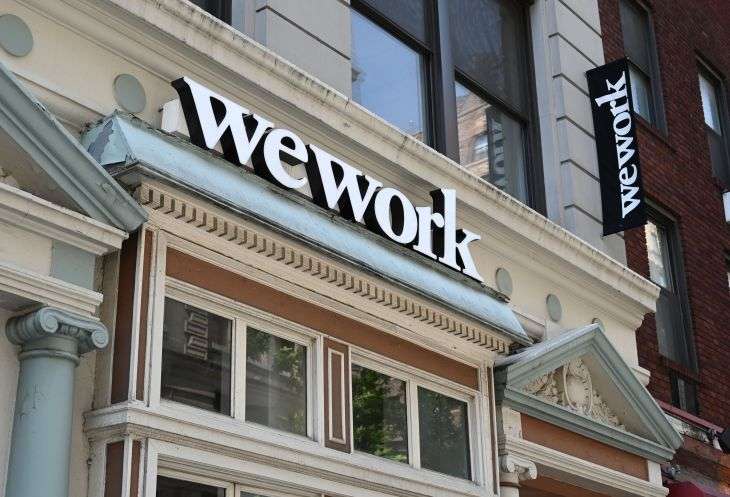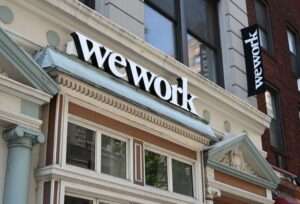Office sharing company WeWork filed for Chapter 11 bankruptcy protection in federal court on Monday, the latest chapter in the spectacular rise and fall of the once high-flying startup.
Valued at $47 billion just two years ago, WeWork aimed to revolutionize commercial real estate by offering flexible shared office spaces to freelancers, startups and enterprises. But the company failed to deliver on its lofty ambitions and has now filed for bankruptcy, leaving its future in doubt.
WeWork said the bankruptcy only applies to its US and Canada operations. The filing lists liabilities ranging from $10 billion to $50 billion, underscoring the company’s precarious financial position.
“I am deeply grateful for the support of our financial stakeholders as we work together to strengthen our capital structure and expedite this process through the Restructuring Support Agreement,” said WeWork CEO David Tolley in a statement.
The bankruptcy caps a turbulent period for WeWork following its aborted effort to go public in 2019. The company was poised for an IPO valuing it at $47 billion before investors balked at massive losses and erratic management under co-founder Adam Neumann.
SoftBank, its largest backer, was forced to bail out WeWork, eventually providing over $13 billion in financing. But the company never recovered, with the pandemic dealing a further blow as clients exited leases en masse.
WeWork warned last August it could face bankruptcy as losses mounted. The filing delivers a stunning comedown for a company once considered a shining unicorn promised to transform commercial real estate.
Rise and Fall of a Real Estate Unicorn
WeWork was launched in 2010, pioneering the concept of offering flexible, short-term leases for stylishly designed shared office spaces. It targeted freelancers, startups and mobile workers who desire community and flexibility.
The company expanded aggressively across the US and globally, fueled by billions in funding from marquee investors like SoftBank. Iconic buildings in prime locations were branded with WeWork’s trademark neon signage and quirky interiors.
At its peak in 2019, WeWork leased over 5 million square feet in 700 locations across 29 countries. It was the largest private office tenant in central London and Manhattan.
Windfall profits seemed assured as demand kept growing. SoftBank’s Masayoshi Son touted WeWork as embodying the “next-generation real estate business” he was creating.
Enthusiasm reached fever pitch by early 2019 as WeWork prepared for an IPO. Investment banks suggested the company could be valued at $65 billion or more through a public listing.
The excitement enabled WeWork to raise another $6 billion from SoftBank in January 2019 at a jaw-dropping $47 billion valuation. This cemented its status as one of the world’s most valuable startups.
IPO Prospectus Reveals Startup’s Shaky Foundation
However, WeWork’s foundations proved far shakier than investors believed. When the company released its IPO prospectus in August 2019, it exposed WeWork’s financial vulnerabilities for the first time.
The filing revealed WeWork was losing $1.6 billion a year with unclear prospects of achieving profitability. Buried in the fine print were other red flags, including Neumann securing preferential stock and loans for himself.
The prospectus provoked intense scrutiny from media and investors. Questions swirled over whether the company’s projected $3 trillion market opportunity was realistic. Critics lambasted WeWork’s governance, business model and leadership under Neumann.
The backlash caused WeWork’s planned IPO to implode spectacularly in September 2019. The company failed to drum up investor demand for its stock at anything near the hoped-for $47 billion valuation.
Tepper School of Business Professor Daniel Raff said WeWork’s downfall stemmed from “hiding the realities of a deeply unsound business model.” The IPO debacle exposed this for all to see, he told NPR.
WeWork Ousts Neumann as CEO to Stop Cash Bleed
To salvage WeWork’s future, Neumann was forced out as CEO in September 2019. In his place, SoftBank installed veteran executives Artie Minson and Sebastian Gunningham as co-CEOs.
SoftBank also accelerated additional funding to keep WeWork afloat after its failed IPO left it strapped for cash. The Japanese investment firm ultimately injected over $13 billion into WeWork overall.
The new leadership duo tried to refocus the company on its core business and stem massive losses. They offloaded non-core units, axed thousands of jobs and renegotiated leases to cut costs.
But WeWork could not escape the albatross of long-term leases signed during its growth binge under Neumann. It owed nearly $47 billion in future lease payments as of 2019.
Pandemic Deals Final Blow for Struggling WeWork
Before WeWork could begin stabilizing its business, disaster struck in early 2020 with the arrival of COVID-19.
The pandemic crushed demand for office space as companies ordered employees to work from home indefinitely. Clients rapidly terminated WeWork leases, leaving its hip communal offices empty.
WeWork’s losses ballooned to $3.2 billion in 2020 as revenue plummeted. Memberships shrank from 612,000 in 2019 to 476,000 in 2020. The company closed or sold off dozens of locations and laid off thousands more employees just to try and stop the bleeding.
However, analysts were alarmed to see WeWork was still saddled with $15 billion in minimum lease obligations over the next few years. The company was burning through cash simply to pay for empty office space it could not unload.
Marred by this albatross and COVID’s enduring impact, WeWork’s prospects dimmed significantly. The pandemic “put another nail in the coffin” for a company already on the ropes, Columbia Business School adjunct professor Len Sherman told the New York Times.
SPAC Deal Fails to Revive WeWork’s Declining Fortunes
In 2021, WeWork attempted to revive its fortunes by going public via a merger with a special purpose acquisition company (SPAC). This allowed it to bypass the traditional IPO process that previously doomed it.
However, investor enthusiasm remained muted as WeWork continued to bleed cash and offload underperforming leases. The company was valued at just $9 billion in its SPAC deal, a fraction of its peak valuation.
Since the merger, WeWork’s stock has plunged over 90%, reflecting Wall Street’s ongoing pessimism about the company’s prospects. By August 2022, WeWork stock hovered around just $5 per share.
Over the past year, WeWork has tried to renegotiate leases and find new sources of revenue, such as subletting office space. But losses remain steep, with the company posting a $633 million deficit in Q1 2022.
In its bankruptcy filing, WeWork listed assets between $1 billion and $10 billion alongside its gargantuan liabilities. This underscores the dire financial straits enveloping the once dazzling startup.
Bankruptcy Cements WeWork’s Fall From Grace
For a company valued so extravagantly just a few years ago, WeWork’s Chapter 11 bankruptcy represents a stunning change in fortunes. It seems the company’s business model was not as revolutionary as it appeared under the spell of Neumann’s bombastic salesmanship.
In many ways, COVID-19 simply accelerated an inevitable reckoning for WeWork’s underlying weaknesses — including runaway losses, murky path to profitability and substantial lease obligations.
Nonetheless, the swiftness and completeness of WeWork’s reversal from cash-flush unicorn to bankrupt has been remarkable. It illustrates the fickle nature of hype-driven startup valuations.
The Chapter 11 restructuring offers WeWork a chance to shed debt and rightsize its business. However, the flexible office model faces an uncertain future given the rise of remote work. Significant challenges lie ahead as WeWork tries to chart a viable path forward.
Yet the company remains adamant that its bankruptcy is merely a bump in the road. “WeWork is charting a path to operational profitability by advancing our plans to improve location profitability and margins,” CEO Tolley insisted.
Only time will tell whether WeWork can reemerge from bankruptcy as a sustainable business worthy of investors’ renewed confidence. But for now, its epic fall from a $47 billion valuation to bankruptcy court represents a cautionary tale of startup hubris and mismanagement.
WeWork’s filing for Chapter 11 bankruptcy protection marks a dramatic turning point for the once high-flying startup following the collapse of its attempted IPO in 2019. Valued at $47 billion by lead investor Softbank, WeWork saw its value evaporate as flaws in its business model were exposed.
The company tried to cut costs and stabilize after replacing founder Adam Neumann as CEO, but never recovered from massive losses tied to long-term lease liabilities. The pandemic dealt a final blow as office usage and WeWork memberships plunged.
While restructuring through bankruptcy may help WeWork pare back unsustainable leases and debt, the company faces an uncertain future given upheaval in the office rental sector. WeWork’s fall from its dizzying $47 billion valuation to bankruptcy court underscores the fickleness of startup






















